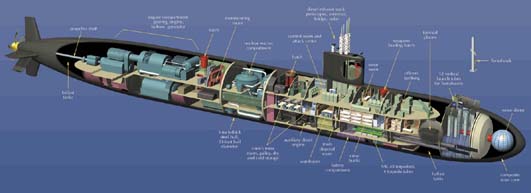
HOW A SUBMARINE IS ORGANIZED
Few modern institutions can rival the nuclear submarine for complexity and absolute self-sufficiency. The often inhospitable environment of the vast sea only intensifies the need for coordination of each crewman's activities. The keystone of the submarine organization is the Commanding Officer, the Captain of the ship. The responsibility for each operation of the submarine, in fact, the responsibility of each individual aboard, converge at the command level and create the Commanding Officer's ultimate charge: to successfully carry out all assigned missions. The Commanding Officer is empowered to employ whatever measures are required in his judgement.
Second in command is the Executive Officer, always next senior in rank to the Captain and not far from attaining his own command. The XO, as he is informally called, offers his wide ranging experience to the submarine organization through direct coordination of the administrative and training activities of the ship. His knowledge and position extend his responsibilities and interests to every aspect of submarine operations.
The remainder of the ship's force is comprised of four departments: Navigation/Operations, Weapons, Engineering, and Supply. The first three are ordinarily led by the more senior officers of the ship who rank just below the Executive Officer. The more junior officers are assigned within these departments to act as division officers. Divisions are the smallest organizational units aboard, and consist of groups of enlisted specialists organized according to skills. Each division is led by a leading petty officer, normally a chief petty officer, who provides deck plate level leadership and possesses in-depth technical expertise gained through years of experience.
Every piece of material on the ship from the propeller to the paint job is assigned to a division and finally to an individual technician for its care. Each of these men is an expert not only in the technical functions to which his special training has been directed, but also in the demands of administration, leadership, and instruction of his shipmates.
Each crew member is a part of a second organization aboard the ship, the watch organization, which is designed to conduct and coordinate the actual operations of the ship around the clock. This organization is ordinarily divided into three similar groups called sections. At any given time on the submarine one of these sections has the watch. Each watch section is headed by the Officer of the Deck who carries out the Commanding Officer's orders during the hours of his watch. It is the Officer of the Deck who orders the ship's course, speed, and depth, and coordinates all shipboard evolutions. He is assisted by the Engineering Officer of the Watch, who controls the reactor plant and all engineering evolutions in the propulsion plant.
Each watch section consists of watchstanders throughout the ship who stand alertly by their equipment and stations for the duration of each watch. For example, helmsmen, who steer the ship; throttlemen, to control the steam turbines; sonar operators, who silently probe the environment; reactor operators, who control the ship's remarkable energy source; torpedomen, to service and launch a submarine's weapons; radio operators, who continually maintain an invisible link with command centers ashore; and electricians, who supply power from the reactor for virtually every service on the ship.